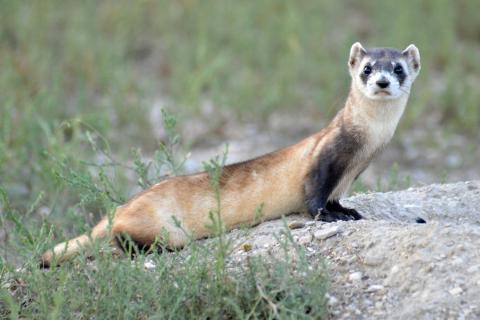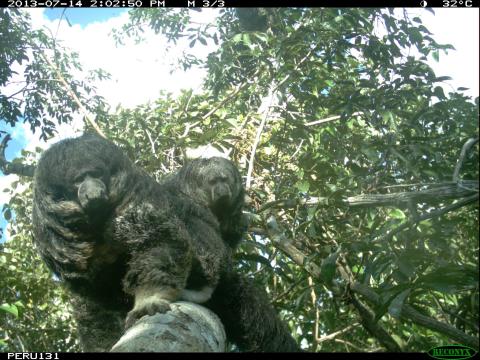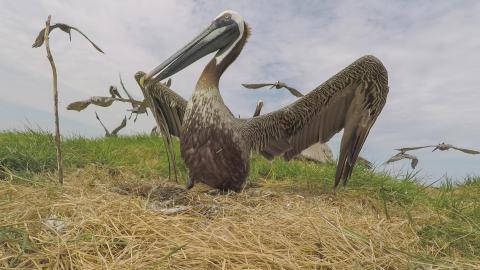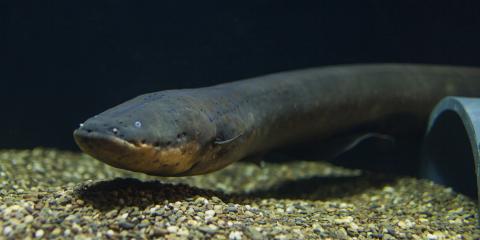News Archive
Filter By
- Abyssinian ground hornbill
- Addax
- Aldabra tortoise
- Allen's swamp monkey
- Alpaca
- American alligator
- American avocet
- American bison
- American flamingo
- American wigeon
- Andean bear
- Aquatic caecilian
- Arapaima
- Asian elephant
- Asian small-clawed otter
- Asian water dragon
- Australian snake-necked turtle
- Bald eagle
- Baltimore oriole
- Barred owl
- Bearded emperor tamarin
- Beaver
- Bennett's wallaby
- Binturong
- Black-and-white ruffed lemur
- Black-crowned night heron
- Black-footed ferret
- Black-tailed prairie dog
- Black-throated blue warbler
- Blue-billed curassow
- Blue crane
- Bobcat
- Brown pelican
- Bufflehead
- California sea lion
- Canvasback
- Cedar waxwing
- Channel catfish
- Cheetah
- Chicken
- Chinese alligator
- Chinese three-striped box turtle
- Clouded leopard
- Collared brown lemur
- Common raven
- Common yellowthroat
- Corals and sea anemones (anthozoa)
- Cow
- Crocodile monitor
- Cuban crocodile
- Dama gazelle
- Degu
- Dunlin
- Eastern corn snake
- Eastern indigo snake
- Eastern newt
- Eastern red-backed salamander
- Eastern screech-owl
- Eld's deer
- Electric eel
- Emperor newt
- Fennec fox
- Fishing cat
- Gaboon viper
- Geoffroy's marmoset
- Gharial
- Giant leaf-tailed gecko
- Giant panda
- Goat
- Golden-headed lion tamarin
- Golden lion tamarin
- Gray seal
- Gray wolf
- Green tree python
- Grevy's zebra
- Guam kingfisher (sihek)
- Guam rail (ko’ko’)
- Guinea pig
- Harbor seal
- Hartmann's mountain zebra
- Hawk-headed parrot
- Hellbender
- Home's hinge-back tortoise
- Hooded crane
- Iranian fat-tailed gecko
- Japanese giant salamander
- King vulture
- Komodo dragon
- Kori bustard
- Kunekune pig
- Land hermit crab
- Larger Malay mouse-deer
- Lemur leaf frog
- Lesser hedgehog tenrec
- Lesser kudu
- Lion
- Loggerhead shrike
- Long-tailed chinchilla
- Long-tailed salamander
- Maned wolf
- Meerkat
- Miniature donkey
- Naked mole-rat
- North American porcupine
- North American river otter
- Northern Luzon giant cloud rat
- Northern pine snake
- Northern pintail
- Northern red salamander
- Northern snakehead fish
- Northern tree shrew
- North Island brown kiwi
- Norway rat
- Orangutan
- Orchard oriole
- Ossabaw Island hog
- Ostrich
- Ovenbird
- Pallas's cat
- Panamanian golden frog
- Patagonian mara
- Persian onager
- Philippine crocodile
- Prehensile-tailed porcupine
- Prevost's squirrel
- Przewalski's horse
- Pygmy slow loris
- Red-crowned crane
- Red-fronted lemur
- Red-rumped agouti
- Red-winged blackbird
- Red knot
- Red panda
- Red River hog
- Red ruffed lemur
- Red wolf
- Ring-tailed lemur
- Ruddy duck
- Schmidt's red-tailed monkey
- Scimitar-horned oryx
- Screaming hairy armadillo
- Semipalmated plover
- Semipalmated sandpiper
- Siamang
- Sitatunga
- Sloth bear
- Southern lesser galago
- Southern swamp sparrow
- Southern tamandua
- Spider tortoise
- Striped skunk
- Tanagers
- Tentacled snake
- Tiger
- Titi monkey
- Turkey
- Twig catfish
- Two-toed sloth
- Vietnamese mossy frog
- Virginia opossum
- Von der Decken's hornbill
- Western lowland gorilla
- White-cheeked gibbon
- White-faced saki
- White-naped crane
- White-nosed coati
- Whooping crane
Displaying 1126 - 1150 of 2363 articles.

Monkey Business: 2017 Gala
On Sept. 28, 450 party animals gathered for some Monkey Business—the Smithsonian's National Zoo and Conservation Biology Institute’s first-ever gala. Set in the tropical rainforest of Borneo, the evening honored Harrison Ford and Betty White with the James Smithson Bicentennial Medal for their many...

Black-Footed Ferret Update
SCBI is part of the Black-footed Ferret Recovery Program, which currently has a genomics workgroup that’s focused on better understanding the species genome and its role in breeding success.

Taking a Swing at Connecting Habitat with Treetop Bridges
How do arboreal species in South America—such as the spider monkey and the tamandua—use tree canopies to move from place to place? Smithsonian Conservation Biology Institute biologist Tremaine Gregory scaled the forest to find out. As a member of the Center for Conservation and Sustainability team...

Where Do You Go, Brown Pelican?
For the first time ever, the Smithsonian Migratory Bird Center has teamed up with the Maryland Department of Natural Resources to track the migration of brown pelicans. In this Q&A below, research ecologist Autumn-Lynn Harrison talks about the migration.
Smithsonian Scientists Find Deadly Pathogen Not Present in Pet Salamanders in the United States
In 2016, the international import of 201 salamander species into the United States was restricted in an effort to prevent the newly discovered deadly salamander fungal disease, Batrachochytrium salamandrivorans (Bsal), from entering the country. In a new study, Smithsonian Conservation Biology...
Red Panda Cub Euthanized at the Smithsonian Conservation Biology Institute
We are sad to share that one of red panda Nutmeg’s cubs born June 14 at the Smithsonian Conservation Biology Institute in Front Royal, Virginia, was euthanized Oct. 4. Keepers rushed her to the veterinary hospital after they noticed that she was minimally responsive and had lost weight since her...

Bats in the Lab: Tracking the Path of White-Nose Syndrome
These bats have been dead for more than a century, but they are finding a second “life” as a research specimen. It may sound like a spooky science fiction story, but it is actually the work of scientists at the Smithsonian Conservation Biology Institute’s Center for Conservation Genomics and the...

A Day in the Life of an American Trail Keeper
A stroll down American Trail brings visitors face-to-face with swimming sea lions, busy beavers and resourceful ravens. What visitors may not see are the dedicated keepers working hard behind the scenes preparing diets, training animals and cleaning habitats. Get a glimpse into a day in the life of...

It’s Electric (Fishes)!
Video Visitors seeking to inject a jolt of fun into their trip to the Smithsonian’s National Zoo need look no further than Amazonia’s Electric Fishes Demonstration Lab! The exhibit, which opened Oct. 6, features six species of fish that emit powerful charges, pulses and waves in order to navigate...
New Electric Fishes Exhibit Opens at Smithsonian’s National Zoo
The Amazonia Exhibit at the Smithsonian’s National Zoo is buzzing with a current from a brand-new Electric Fishes Demonstration Lab, opening Oct. 6 at 10 a.m. The multisensory lab is home to a 5-foot-long electric eel, capable of generating up to 800 volts of electricity, four black ghost knifefish...
Smithsonian Conservation Biology Institute Releases Birds to the Wild
Two female Guam rails born at the Smithsonian Conservation Biology Institute in Front Royal, Virginia, were released to the wild in the Commonwealth of the Northern Mariana Islands Sept. 18. This month’s release marks the first time since 1985 that there are more Guam rails in the wild than in human...
Alpaca Dies at Smithsonian's National Zoo
The Smithsonian's National Zoo is mourning the loss of 12-year-old alpaca, Ziggy, who died Sept. 23.
Smithsonian Conservation Biology Institute Open to the Public for Conservation Discovery Day
The 3,200-acre Smithsonian Conservation Biology Institute (SCBI) in Front Royal, Va.—which is the headquarters for the Smithsonian’s National Zoo’s conservation science initiatives and is normally closed to the public—will open its gates Saturday, Oct. 7 from 9 a.m. to 4 p.m. for Conservation...
Two Dama Gazelle Calves Born at the Smithsonian’s National Zoo
The Cheetah Conservation Station at the Smithsonian's National Zoo is celebrating a baby boom of critically endangered dama gazelles. Three calves were born Aug. 30, Sept. 16 and Sept. 18 to mothers Adara, Fahima and Zafirah, respectively.
Giant Panda Mei Xiang Is Not Pregnant
The giant panda team at the Smithsonian’s National Zoo and Conservation Biology Institute has determined that Mei Xiang (may-SHONG) will not give birth this year.
Smithsonian Scientists Publish First Book on the Genetic Management of Fragmented Species Populations
On Sept. 13, Smithsonian scientists and partners published a groundbreaking new book, "Genetic Management of Fragmented Animal and Plant Populations," which addresses one of today's greatest conservation challenges.
Zoo’s Tiger Cub Transferred to San Diego Zoo Safari Park
The Smithsonian’s National Zoo transported its 9-week-old male Sumatran tiger cub to the San Diego Zoo Safari Park, where he will live and thrive with another young male tiger cub.

Behavior Watch for Mei Xiang Begins
The panda team is still waiting to find out if Mei Xiang will give birth or if she is experiencing a pseudopregnancy. Giant pandas’ hormones and behavior mimic a pregnancy even if they are experiencing a pseudopregnancy.
Fall Events at the Smithsonian’s National Zoo
The Smithsonian’s National Zoo and Conservation Biology Institute is hosting Enrichment Day Sept. 16, ZooFiesta Sept. 24 and Conservation Discovery Day Oct. 7.
Dama Gazelle Calf Born at the Smithsonian’s National Zoo
After a five-year hiatus, Cheetah Conservation Station keepers at the Smithsonian’s National Zoo are celebrating the birth of a critically endangered dama gazelle. The male calf was born in an off-exhibit enclosure Aug. 30.
ZooLights, Powered by Pepco, Returns to Smithsonian’s National Zoo
ZooLights—powered by Pepco—at the Smithsonian’s National Zoo is wilder than ever and a perfect holiday event for everyone in the family. Now in its 11th year, the annual free lights festival twinkles from Nov. 24 through Jan. 1, 2018 (except Dec. 24, 25 and 31) from 5 p.m. to 9 p.m.

Singing in the City or Country: How Urbanization Affects the Gray Catbird
What happens when a migratory bird’s path lands it right in an urban area like Washington, D.C.? The city is known for its extensive park system, but can these urban parks support wild birds through the breeding season? Moreover, how do birds’ natural behaviors change when they’re living the city...

How Artificial Insemination Helps Boost Panda Populations
The panda house is closed to the public beginning today, Sept. 1 to provide quiet for Mei Xiang as she enters the final stages of a pregnancy or pseudopregnancy.
